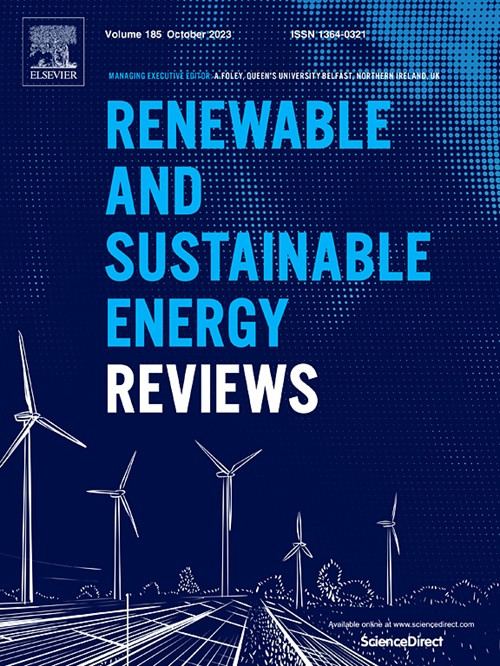解锁智能可穿戴应用:基于纤维素的辐射冷却材料的“潜在代码”
IF 16.3
1区 工程技术
Q1 ENERGY & FUELS
引用次数: 0
摘要
随着科学技术的发展,辐射冷却技术正经历着从“被动冷却”到“智能温控”的范式转变。纤维素基材料由于其独特的光谱调节能力、可定制的各种尺度结构和生物相容性,已成为革命性可穿戴热管理系统的核心候选材料。然而,纤维素基辐射冷却材料的结构、光学和多功能性之间的复杂关系尚未得到系统的讨论和解码,这导致其冷却性能不能满足实际要求。本文综述并分析了纤维素基辐射冷却材料的最新发展策略:(1)系统解构了热辐射调节的三个核心要素:分子振动光谱匹配、多尺度散射结构优化和环境耦合鲁棒性。(2)探索纤维素微纳结构与可穿戴适应性之间的隐藏联系,阐明其在汗液管理和热调节等复杂场景中的独特优势。(3)一种引入“辐射冷却+”路径的新方法,将增强的光热转换与自供电传感器集成设计相结合。此外,本文综述了当前动态光谱控制和可穿戴系统集成方面的研究挑战,为热适应智能纤维素冷却织物的开发提供了理论蓝图,并为可穿戴热管理领域的新研究方向铺平了道路。本文章由计算机程序翻译,如有差异,请以英文原文为准。
Unlocking smart wearable applications: the “potential code” of cellulose-based radiative cooling materials
With the development of science and technology, radiative cooling technology is undergoing a paradigm shift from “passive cooling” to “intelligent temperature control”. Cellulose-based materials have emerged as core candidates for revolutionary wearable thermal management systems due to their unique spectral tuning ability, customizable structures across various scales, and biocompatibility. However, the intricate relationships between structure, optics, and multifunctionality in cellulose-based radiative cooling materials have yet to be systematically discussed and decoded, which results in cooling performance can not meet practical requirements. This review summarizes and analyses the latest development strategies for cellulose-based radiative cooling materials: (1) A systematic deconstruction of the three core elements of thermal radiation regulation: molecular vibrational spectral matching, multi-scale scattering structure optimization, and environmental coupling robustness. (2) An exploration of the hidden connections between cellulose micro-nano structures and wearability adaptability, elucidating their unique advantages in complex scenarios such as sweat management and thermal regulation. (3) A novel approach introducing a “radiative cooling +” pathway that combines enhanced photothermal conversion with the design of self-powered sensor integration. Moreover, this review highlights the current research challenges in dynamic spectral control and wearable system integration, providing a theoretical blueprint for developing thermally adaptive smart cellulose-based cooling fabrics and paving the way for new research directions in the field of wearable thermal management.
求助全文
通过发布文献求助,成功后即可免费获取论文全文。
去求助
来源期刊

Renewable and Sustainable Energy Reviews
工程技术-能源与燃料
CiteScore
31.20
自引率
5.70%
发文量
1055
审稿时长
62 days
期刊介绍:
The mission of Renewable and Sustainable Energy Reviews is to disseminate the most compelling and pertinent critical insights in renewable and sustainable energy, fostering collaboration among the research community, private sector, and policy and decision makers. The journal aims to exchange challenges, solutions, innovative concepts, and technologies, contributing to sustainable development, the transition to a low-carbon future, and the attainment of emissions targets outlined by the United Nations Framework Convention on Climate Change.
Renewable and Sustainable Energy Reviews publishes a diverse range of content, including review papers, original research, case studies, and analyses of new technologies, all featuring a substantial review component such as critique, comparison, or analysis. Introducing a distinctive paper type, Expert Insights, the journal presents commissioned mini-reviews authored by field leaders, addressing topics of significant interest. Case studies undergo consideration only if they showcase the work's applicability to other regions or contribute valuable insights to the broader field of renewable and sustainable energy. Notably, a bibliographic or literature review lacking critical analysis is deemed unsuitable for publication.
 求助内容:
求助内容: 应助结果提醒方式:
应助结果提醒方式:


